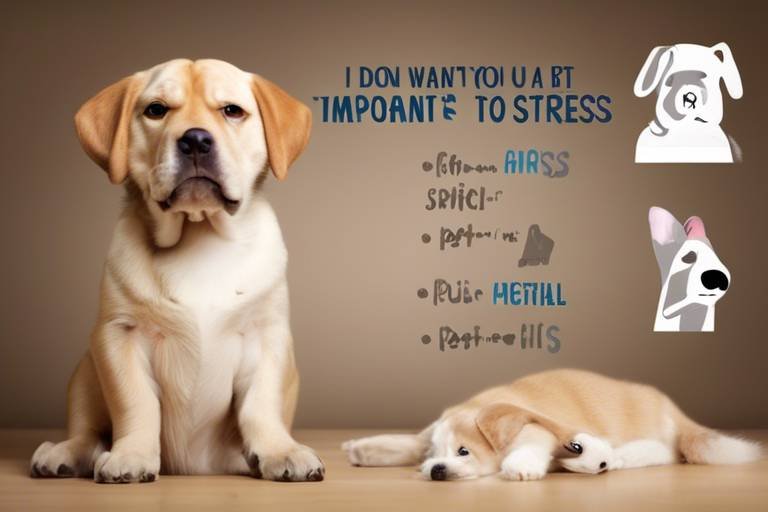What to Do If Your Pet Experiences Severe Anxiety
As a pet owner, it's heartbreaking to witness your furry friend struggle with severe anxiety. Just like us, pets can experience stress and fear, and understanding how to help them is essential for their well-being. Imagine your pet as a little ball of nerves, constantly on edge, unsure of what might happen next. It’s crucial to step in and provide the support they need. In this article, we'll explore effective strategies and solutions for managing severe anxiety in pets, offering insights into understanding their behavior and practical tips for pet owners.
First things first, recognizing the signs of anxiety in your pet is critical. You might notice them pacing, hiding, or even trembling. These behaviors are their way of communicating distress. Just as we might seek comfort during tough times, our pets need that same reassurance. So, let’s dive into what causes these feelings and how you can help alleviate their anxiety, creating a safe and loving environment for them.
Recognizing the signs and symptoms of anxiety in pets is crucial for effective intervention. Pets, much like humans, can experience a range of emotions, and anxiety can manifest in various ways. Some common signs include excessive barking, destructive behavior, and even changes in eating habits. Understanding these signs is the first step toward providing the necessary support. Think of it like deciphering a secret code; once you crack it, you can better understand what your pet is going through.
Identifying the triggers that lead to anxiety in pets can help owners mitigate stress. There are numerous environmental and situational factors that may contribute to your pet's anxious behavior. For example, changes in routine, loud noises, or even new family members can unsettle them. Here are some common triggers:
- Separation from their owner
- Thunderstorms or fireworks
- New environments or changes in routine
- Visitors or unfamiliar animals
Separation anxiety is a prevalent issue in pets, often manifesting when they are left alone. This can be particularly distressing for both pets and their owners. Symptoms may include excessive barking, chewing on furniture, or even soiling the house. Understanding these signs early on can help you address the issue effectively.
Understanding the signs of separation anxiety can help owners identify the issue early. Look out for behaviors such as:
- Excessive barking or howling
- Destructive actions, like chewing or digging
- House soiling, even if they are house-trained
- Clinginess when you are home
There are various treatment methods available for separation anxiety, including training techniques and behavioral therapies. Gradual desensitization, where you slowly accustom your pet to being alone, can be very effective. Additionally, providing them with toys or puzzles can help keep their minds occupied while you’re away, reducing their anxiety.
Many pets experience fear of loud noises, which can lead to severe anxiety. This can be particularly distressing during thunderstorms or fireworks displays. To help your pet feel more secure during these stressful events, consider creating a safe space for them to retreat to. This could be a cozy corner of your home with their favorite blanket and toys.
Implementing behavioral training techniques can significantly reduce anxiety in pets. These methods not only help in managing anxiety but also promote a sense of calmness and confidence in your furry friend. Some effective techniques include desensitization, counter-conditioning, and positive reinforcement.
Desensitization and counter-conditioning are effective strategies to help pets overcome their fears. This involves gradually exposing your pet to the source of their anxiety in a controlled manner, while simultaneously providing positive reinforcement. For example, if your dog is afraid of loud noises, you can play recordings of those sounds at a low volume while rewarding them for calm behavior.
Using positive reinforcement can encourage desired behaviors in anxious pets. Rewarding calmness with treats or praise can help them associate positive experiences with situations that usually cause fear. Think of it as a way to turn their anxiety into confidence, one treat at a time!
Sometimes, professional help is necessary for managing severe anxiety in pets. If you find that your efforts are not yielding the desired results, it might be time to seek assistance from veterinarians or animal behaviorists. They can provide valuable insights and tailored strategies for your specific situation.
Veterinarians can offer medications and therapies that may be recommended to alleviate severe anxiety. These interventions can be particularly helpful in severe cases where behavioral techniques alone may not suffice. Your vet will guide you on the best options for your pet's unique needs.
Consulting with a behavioral specialist can offer tailored strategies for your pet's anxiety. These professionals specialize in animal behavior and can provide insights that you might not have considered. Working with a specialist can be a game-changer, helping you develop a comprehensive plan to support your pet.
Q: How can I tell if my pet is anxious?
A: Look for signs such as excessive barking, hiding, destructive behavior, or changes in eating habits.
Q: What should I do if my pet is scared of loud noises?
A: Create a safe space for them and consider using calming products or training techniques to help them cope.
Q: When should I consult a veterinarian for my pet's anxiety?
A: If your pet's anxiety is severe or persistent, it's best to consult a veterinarian for professional advice and treatment options.

Understanding Pet Anxiety
Recognizing the signs and symptoms of anxiety in pets is crucial for effective intervention. Just like humans, our furry friends can feel overwhelmed and stressed, often displaying behaviors that indicate they are not in a comfortable state. Understanding pet anxiety is the first step toward helping your beloved companion. Have you ever noticed your pet pacing back and forth, or perhaps they hide under the bed during a thunderstorm? These are clear signals that something is amiss.
Common signs of anxiety in pets can include:
- Excessive barking or meowing: This can be a way for pets to express their distress.
- Destructive behavior: Chewing furniture or scratching at doors can indicate a pet's anxiety.
- Changes in appetite: A pet that suddenly refuses to eat or overeats may be experiencing anxiety.
- Hiding: Pets often seek solace in small, enclosed spaces when they feel anxious.
- Increased aggression: Sometimes, anxious pets may lash out, which can be alarming for owners.
Understanding the underlying causes of anxiety is equally important. Pets can experience anxiety due to a variety of factors, including:
- Changes in their environment: Moving to a new home, the arrival of a new family member, or even rearranging furniture can disrupt a pet's sense of security.
- Traumatic experiences: Past abuse or a frightening event can leave a lasting impact on a pet's mental health.
- Genetics: Some breeds are more predisposed to anxiety than others, making them more sensitive to stressors.
It's essential for pet owners to be observant and proactive. Just like a parent would seek to understand their child's fears, pet owners must learn to interpret their pets' signals. By acknowledging these behaviors, you can begin to formulate a plan to help alleviate their anxiety. For instance, if your dog displays signs of anxiety during storms, creating a safe space with their favorite toys and blankets can provide comfort. Understanding pet anxiety is not just about recognizing the symptoms; it’s about fostering a supportive environment that promotes their well-being.
In summary, being aware of the signs and underlying causes of anxiety in pets is the foundation for effective management. It’s a journey that requires patience and empathy, but the bond you strengthen with your pet through this process is invaluable. Remember, you are their voice, and understanding their anxiety is the first step in helping them feel safe and loved.

Common Triggers of Anxiety
Understanding the common triggers of anxiety in pets is essential for any pet owner who wants to create a nurturing and calm environment. Just like humans, pets can be sensitive to various situations and stimuli that may cause them to feel anxious or stressed. Recognizing these triggers is the first step in helping your furry friend manage their anxiety. Some of the most common triggers include changes in their environment, loud noises, and social interactions.
One significant factor that can lead to anxiety is environmental changes. Pets thrive on routine, and any disruption can throw them into a state of distress. For example, moving to a new home, rearranging furniture, or even a new family member can create feelings of insecurity in your pet. They may not understand why their familiar surroundings have changed, leading to anxiety. It's vital to introduce these changes gradually and provide comfort during the transition.
Another common trigger is loud noises. Many pets, especially dogs, can develop a fear of thunderstorms, fireworks, or even loud household appliances. These sounds can be startling and may lead to panic attacks. If your pet has a history of reacting negatively to loud noises, it’s crucial to identify these triggers early on. You might notice behaviors such as hiding, trembling, or excessive barking when they hear these sounds. Providing a safe space where they can retreat during these events can help mitigate their anxiety.
Social interactions can also be a significant source of anxiety for some pets. This is particularly true for those that are not well-socialized or have had negative experiences with other animals or people. For instance, if a pet has been attacked by another dog, they may develop a fear of all dogs, leading to anxiety during walks or playdates. It's important to monitor your pet's body language during these interactions and take steps to ensure they feel safe and secure.
Below is a table summarizing some common triggers of anxiety in pets:
| Trigger | Description |
|---|---|
| Environmental Changes | Changes in surroundings that disrupt routine, such as moving homes or new family members. |
| Loud Noises | Fear of sounds like thunderstorms, fireworks, or loud appliances that can cause panic. |
| Social Interactions | Negative experiences with other pets or people can lead to anxiety during social situations. |
By being aware of these triggers, you can take proactive steps to reduce your pet's anxiety. This might include creating a safe space for them during storms, gradually introducing them to new environments, or seeking professional help if social interactions become overwhelming. Remember, just like us, pets need time to adjust and feel secure in their surroundings.
- What are the signs that my pet is anxious? Look for signs such as excessive barking, hiding, trembling, or destructive behavior.
- Can anxiety in pets be treated? Yes, there are various treatment options available, including behavioral training and medication.
- How can I help my pet during thunderstorms? Create a safe space for them, use calming products, and stay calm yourself to help soothe their anxiety.
Separation Anxiety
Separation anxiety in pets is a common and distressing condition that many pet owners face. It occurs when your furry friend becomes overly stressed when left alone or separated from their owner. Imagine how you might feel if you were suddenly left in a strange place without your loved ones—that's how your pet feels! Recognizing the signs early can make a significant difference in managing their anxiety and restoring their sense of security.
Symptoms of separation anxiety can vary from mild to severe, and they often manifest in ways that can be both heartbreaking and frustrating for pet owners. Common behaviors include excessive barking or howling, destructive chewing, and even inappropriate elimination in the house. Some pets may pace back and forth, while others might hide or try to escape. It's essential to observe your pet closely to identify these behaviors. Understanding that these actions stem from fear, not disobedience, is crucial in addressing the issue effectively.
To help alleviate separation anxiety, it's vital to implement a structured routine that helps your pet feel more secure. Here are a few strategies that can make a world of difference:
- Gradual Desensitization: Start by leaving your pet alone for short periods, gradually increasing the duration as they become more comfortable.
- Positive Reinforcement: Reward your pet with treats or praise when they remain calm during your absence.
- Safe Space: Create a cozy, safe area for your pet to retreat to when they feel anxious. This could be a comfortable bed or a crate with their favorite toys.
Additionally, some pet owners find that engaging in interactive toys or puzzle feeders can keep their pets occupied and distracted while they are away. These activities can help channel your pet's energy and reduce their focus on your absence. Remember, patience is key! It may take time for your pet to adjust, but with consistent efforts, you can help them feel more secure.
In severe cases, it may be beneficial to consult a professional trainer or a veterinarian. They can provide tailored strategies and, if necessary, recommend medications that can help ease your pet's anxiety. Just as you would seek help for your own anxiety, don't hesitate to reach out for support when it comes to your beloved pet.
Ultimately, understanding and addressing separation anxiety is a journey that requires compassion and dedication. By being proactive and implementing effective strategies, you can help your pet navigate their feelings and foster a sense of security, even when you’re not around.
Signs of Separation Anxiety
Recognizing the signs of separation anxiety in your pet is vital for timely intervention. Pets, much like humans, can experience overwhelming feelings of distress when separated from their loved ones. This emotional turmoil can manifest in various behaviors, some of which may be alarming to pet owners. It's essential to understand these signs to help your furry friend cope better.
One of the most common indicators of separation anxiety is excessive barking or howling. If your pet seems to vocalize excessively when you leave the house, this could be a cry for help. Additionally, many pets resort to destructive behaviors as a way to express their anxiety. This might include chewing on furniture, scratching at doors, or tearing up household items. Such actions are not only damaging but also highlight the emotional distress your pet is experiencing.
Another significant sign to watch for is house soiling, even if your pet is typically well trained. When faced with anxiety, pets may lose control of their bladder or bowels, leading to accidents inside the house. This behavior can be particularly frustrating for owners but should be viewed as a symptom of anxiety rather than a deliberate act of defiance.
In addition to these behaviors, some pets may exhibit clinginess or an inability to be alone, following you from room to room or becoming overly anxious when you prepare to leave. Others might display signs of distress such as pacing, drooling, or even trembling. These physical manifestations often indicate that your pet is struggling with their emotions.
To summarize, here are some key signs of separation anxiety:
- Excessive barking or howling
- Destructive behaviors (chewing, scratching)
- House soiling despite being trained
- Clinginess or difficulty being alone
- Pacing, drooling, or trembling
Understanding these signs can empower you to take action and seek appropriate help for your pet. By recognizing the symptoms early, you can implement strategies or consult professionals to alleviate your pet's anxiety, ensuring a happier and healthier life for both you and your furry companion.
Q: What should I do if I notice signs of separation anxiety in my pet?
A: If you observe signs of separation anxiety, it's crucial to consult with your veterinarian or an animal behaviorist. They can provide tailored strategies and solutions to help your pet cope.
Q: Can separation anxiety be treated effectively?
A: Yes, many pets can overcome separation anxiety with the right training, behavioral techniques, and, in some cases, medication prescribed by a veterinarian.
Q: Are certain breeds more prone to separation anxiety?
A: Some breeds, particularly those that are highly social or have strong bonds with their owners, may be more susceptible to separation anxiety. However, it can affect any pet, regardless of breed.
Q: How long does it take to see improvements in my pet's anxiety?
A: The timeline for improvement can vary based on the individual pet and the severity of their anxiety. Consistent training and patience are key to helping your pet feel more secure.
Treatment Options for Separation Anxiety
When it comes to tackling separation anxiety in pets, there’s no one-size-fits-all solution. Each pet is unique, and what works for one may not work for another. However, there are several effective treatment options that can help alleviate your furry friend's distress. First and foremost, it's essential to create a calm and secure environment for your pet. This can involve establishing a safe space where they can retreat when feeling anxious. Consider using a cozy bed or crate, adorned with their favorite toys and blankets, to create a comforting atmosphere.
Another powerful tool in your arsenal is behavioral training. Techniques such as desensitization and counter-conditioning can be particularly effective. Desensitization involves gradually exposing your pet to the situations that trigger their anxiety, starting at a level that doesn’t provoke a strong reaction. For instance, if your pet becomes anxious when you leave the house, you might start by practicing short departures and gradually increasing the duration. This slow exposure helps your pet learn that being alone isn’t as scary as they might think.
Counter-conditioning works in tandem with desensitization. It involves changing your pet’s emotional response to the anxiety-inducing situation by pairing it with something positive. For example, you can give your pet a special treat or toy only when you leave the house. This way, they start to associate your departures with something enjoyable, which can significantly reduce their anxiety over time.
In addition to these behavioral techniques, positive reinforcement plays a crucial role in managing separation anxiety. Rewarding your pet for calm behavior can help reinforce the idea that being alone isn’t something to fear. For instance, when you come home, instead of immediately showering them with attention, wait until they are calm before giving them affection. This teaches them that calm behavior is what earns your love and attention.
Sometimes, despite our best efforts, pets may require additional support. In such cases, consulting with a veterinarian can be a wise decision. They may recommend medications that can help ease your pet's anxiety. These medications can be particularly helpful in the short term while you work on behavioral modifications. It's important to remember that medication is often most effective when combined with behavioral therapy.
Lastly, don’t hesitate to reach out to a professional animal behaviorist. These specialists can provide tailored strategies to address your pet’s specific anxiety triggers. They can also guide you on how to implement training techniques effectively, ensuring that you’re on the right path to helping your beloved pet. Working with a professional can make a world of difference, especially if you feel overwhelmed or unsure about how to proceed.
- How long does it take to see improvements in my pet's separation anxiety? - Every pet is different, but with consistent training and support, many owners begin to see improvements within a few weeks.
- Are there any natural remedies for separation anxiety? - Yes, some pet owners find success with natural supplements like calming treats or pheromone diffusers, but it's essential to consult your vet before trying new products.
- Can separation anxiety be completely cured? - While some pets may overcome their anxiety entirely, others may need ongoing management. The goal is to reduce their anxiety levels and improve their quality of life.
- Is it normal for pets to have separation anxiety? - Yes, many pets experience some level of separation anxiety, especially if they have strong attachments to their owners.
Noise Phobia
Many pets, just like humans, can experience intense fear and anxiety when exposed to loud noises. This phenomenon, known as , can be triggered by various sounds such as thunderstorms, fireworks, or even the vacuum cleaner. Imagine your furry friend trembling in a corner, ears pinned back, and eyes wide with fear—it's heartbreaking, isn't it? Understanding noise phobia is the first step in helping your pet cope with this distressing condition.
Noise phobia can stem from a variety of factors, including genetics, early experiences, and even changes in the environment. For instance, a dog that has had a traumatic experience during a thunderstorm may develop an aversion to similar sounds in the future. As pet owners, we often overlook the impact of these experiences, but they can leave a lasting impression on our pets. Recognizing the signs of noise phobia is essential; symptoms can range from excessive barking and destructive behavior to more subtle signs like hiding or seeking comfort from their owner.
So, what can you do to help your anxious pet when the world gets too loud? Here are a few strategies to consider:
- Create a Safe Space: Designate a quiet area in your home where your pet can retreat during stressful events. This space should be comfortable and familiar, filled with their favorite toys and blankets.
- Use Calming Products: There are various products available, such as calming collars, pheromone diffusers, and anxiety wraps, that can help soothe your pet during noisy situations.
- Sound Therapy: Gradually introducing your pet to recorded sounds of thunderstorms or fireworks at a low volume can help desensitize them over time.
Additionally, it's important to remember that every pet is unique. What works for one may not work for another. Some pets may require more structured interventions, while others might respond well to simple changes in their environment. If your pet's noise phobia is severe, it may be time to consult with a professional. A veterinarian or animal behaviorist can provide tailored strategies and may recommend treatments to help your furry friend find peace amidst the chaos.
Q: Can all pets develop noise phobia?
A: Yes, while it is more common in dogs, cats and other pets can also experience noise phobia. Individual temperament and past experiences play a significant role in its development.
Q: How can I tell if my pet has noise phobia?
A: Signs include trembling, hiding, excessive barking or meowing, destructive behavior, and attempts to escape. If your pet shows these signs during loud events, they may have noise phobia.
Q: Are there medications available for noise phobia?
A: Yes, veterinarians can prescribe medications to help manage severe anxiety in pets. It’s important to discuss this option with your vet to determine the best course of action for your pet.
By understanding noise phobia and implementing effective strategies, you can help your pet navigate their fears and create a more peaceful environment for both of you.

Behavioral Training Techniques
When it comes to managing severe anxiety in pets, can be a game-changer. Just like humans, pets can learn to cope with their fears and anxieties through consistent training and positive reinforcement. Imagine teaching your pet to feel safe and secure, even in situations that typically trigger their anxiety. It’s not just about calming them down; it’s about empowering them to face their fears with confidence.
One of the most effective methods is desensitization. This involves gradually exposing your pet to the source of their anxiety in a controlled manner. For example, if your dog is afraid of thunderstorms, you might start by playing a recording of thunder at a very low volume while offering treats and praise. Over time, as your pet becomes more comfortable with the sound, you can increase the volume. This method can take time, but the results are often worth the effort.
Another powerful technique is counter-conditioning. This method focuses on changing your pet's emotional response to a trigger. For instance, if your cat becomes anxious during car rides, you can create a positive association by feeding her treats or playing with her favorite toy during the ride. The goal is to replace fear with something enjoyable, thus altering her perception of the situation.
In addition to these techniques, positive reinforcement is crucial. This means rewarding your pet for calm behavior rather than punishing them for anxious behavior. For example, if your dog remains calm during a noisy event, reward him with a treat or praise. This approach not only encourages good behavior but also builds trust between you and your pet. Remember, patience is key! Training takes time, and consistency will help reinforce the behaviors you want to see.
To further enhance your training efforts, consider creating a structured training schedule. This can include short, daily sessions where you practice desensitization or counter-conditioning techniques. Keeping these sessions brief but frequent helps maintain your pet's interest and prevents them from becoming overwhelmed. Here’s a simple example of a weekly training schedule:
| Day | Training Focus | Duration |
|---|---|---|
| Monday | Desensitization to Thunder Sounds | 10 minutes |
| Tuesday | Counter-Conditioning during Car Rides | 15 minutes |
| Wednesday | Positive Reinforcement for Calm Behavior | 10 minutes |
| Thursday | Desensitization to Fireworks Sounds | 10 minutes |
| Friday | General Training and Play | 15 minutes |
| Saturday | Positive Reinforcement for Calmness | 10 minutes |
| Sunday | Review and Relaxation Time | 20 minutes |
By following a structured approach, you can help your pet develop coping mechanisms that reduce their anxiety over time. Remember, it’s all about creating a safe and positive environment where your pet feels loved and secure. With dedication and the right techniques, you can transform your pet’s anxiety into confidence.
Q: How long does it take to see results from behavioral training?
A: The timeline can vary greatly depending on the individual pet and the severity of their anxiety. Some pets may show improvement within a few weeks, while others may take several months. Consistency and patience are essential!
Q: Can I train my pet myself, or should I seek professional help?
A: While many pet owners can successfully implement training techniques at home, seeking the help of a professional trainer or behaviorist can provide tailored strategies and support, especially for severe cases of anxiety.
Q: Are there any risks associated with behavioral training?
A: When done correctly, behavioral training is safe and beneficial. However, if a pet is pushed too quickly into a situation that causes anxiety, it could worsen their fear. Always proceed at a pace that is comfortable for your pet.
Desensitization and Counter-Conditioning
Desensitization and counter-conditioning are two powerful techniques that can transform your pet's fearful reactions into more positive behaviors. Imagine your pet encountering a trigger, like the sound of thunder, and instead of cowering in fear, they remain calm and relaxed. This transformation is possible through a gradual and systematic approach to managing anxiety.
Desensitization involves exposing your pet to the anxiety-inducing stimulus at a level that does not provoke a fearful response. For instance, if your dog is afraid of loud noises, you might start by playing recordings of soft thunder sounds at a low volume while engaging them in a fun activity, such as playing with their favorite toy. Over time, as your pet becomes accustomed to the sound, you can gradually increase the volume. The key here is to move at your pet's pace—if they show signs of distress, you need to dial it back and allow them to acclimate at a slower rate.
Counter-conditioning works hand-in-hand with desensitization. While desensitization helps your pet get used to the trigger, counter-conditioning changes their emotional response to it. This is achieved by pairing the anxiety trigger with something your pet loves, such as treats or praise. For example, if your dog is scared of thunderstorms, you can offer them a high-value treat whenever they hear the sound of thunder, even if it’s just a faint rumble. Over time, your pet will begin to associate the sound with positive experiences, effectively reducing their fear.
Implementing these techniques requires patience and consistency. Here’s a simple step-by-step guide to get you started:
- Identify the specific trigger that causes anxiety in your pet.
- Start with a very low level of exposure to the trigger while offering rewards.
- Gradually increase the exposure as your pet becomes more comfortable.
- Continue to reward calm behavior and progress at your pet’s pace.
- Monitor your pet's reactions and adjust the approach if necessary.
It's important to remember that every pet is unique, and what works for one may not work for another. If you find that your pet's anxiety persists despite your efforts, it might be time to consult with a professional who can tailor a program specifically for your furry friend. The journey to overcoming anxiety can be challenging, but with the right strategies, you can help your pet live a happier, more relaxed life.
- How long does desensitization take? The duration varies based on the individual pet and the severity of their anxiety. Some pets may show improvement within weeks, while others may require several months.
- Can I use desensitization and counter-conditioning together? Absolutely! In fact, they work best when used in conjunction with each other, as they address both exposure and emotional response.
- What if my pet doesn't respond to these techniques? If you notice little to no improvement, consider seeking advice from a veterinarian or a certified animal behaviorist.
Positive Reinforcement Strategies
When it comes to helping our furry friends overcome anxiety, can be a game-changer. Imagine this: your pet is feeling anxious, and instead of scolding or punishing them for their behavior, you shower them with love and rewards for calmness. This approach not only fosters a stronger bond between you and your pet but also encourages them to associate positive experiences with situations that typically trigger their anxiety.
So, how does it work? The key lies in understanding what motivates your pet. For some animals, it might be treats, while for others, it could be praise or playtime. By identifying their preferred rewards, you can create a tailored plan that reinforces desirable behaviors. For instance, if your dog tends to bark excessively during thunderstorms, you can start by rewarding them with a treat when they remain quiet. Over time, this will help them learn that calmness leads to positive outcomes.
Here’s a simple step-by-step guide to implementing positive reinforcement strategies:
- Identify Triggers: Observe your pet to determine what specifically causes their anxiety.
- Set Up a Controlled Environment: Create a safe space where your pet can feel secure.
- Use Rewards: Whenever your pet exhibits calm behavior in the presence of their triggers, immediately reward them.
- Be Consistent: Consistency is crucial. Make sure everyone in your household follows the same training approach.
- Gradually Increase Exposure: Slowly introduce your pet to their triggers while continuing to reward calm behavior.
It's important to remember that patience is key. Just like us, pets need time to adjust and learn. If you find that your pet is struggling, don't hesitate to seek advice from a professional trainer who specializes in positive reinforcement techniques. They can provide valuable insights and help you refine your approach.
In conclusion, positive reinforcement is not just about treats; it's about creating a nurturing environment where your pet feels safe and valued. By focusing on rewarding calmness and desirable behaviors, you can help your pet navigate their anxiety with greater ease and confidence. After all, a happy pet means a happy home!
Q: How long will it take to see improvements using positive reinforcement?
A: The timeline varies depending on the individual pet and the severity of their anxiety. With consistency and patience, many pet owners notice improvements within a few weeks.
Q: Can I use positive reinforcement for all types of anxiety?
A: Yes! Positive reinforcement can be adapted to address various types of anxiety, including separation anxiety and noise phobias.
Q: What if my pet doesn’t respond to treats?
A: Not all pets are motivated by food. Consider using toys, praise, or playtime as alternatives to treats.
Q: Are there any risks associated with positive reinforcement?
A: Generally, positive reinforcement is safe and effective. However, ensure that you don’t inadvertently reward anxious behaviors, such as barking or whining.

Consulting a Professional
When your beloved pet is grappling with severe anxiety, it can be heart-wrenching to watch. You may feel helpless, wondering what more you can do to ease their distress. Sometimes, despite our best efforts, we need to recognize when it's time to seek help from a professional. Consulting a veterinarian or an animal behaviorist can provide tailored solutions that address your pet's unique needs. These professionals bring a wealth of knowledge and experience that can help you navigate the complexities of pet anxiety.
It's essential to understand that not all pets respond to the same treatments. Just like humans, pets have individual personalities and triggers. A professional can help identify specific factors contributing to your pet's anxiety and suggest appropriate interventions. Whether it's through behavioral therapies, medications, or a combination of both, having an expert on your side can make a significant difference in your pet's quality of life.
So, when should you consider consulting a professional? Here are some signs that it might be time:
- If your pet's anxiety is affecting their daily life and yours.
- When home remedies and training techniques have failed to produce results.
- If your pet is exhibiting severe behaviors, such as aggression or self-harm.
- When you feel overwhelmed and unsure of how to help.
During a consultation, you can expect a thorough assessment of your pet's behavior, environment, and medical history. The veterinarian or behavioral specialist will likely ask a series of questions aimed at understanding your pet's anxiety triggers. They may observe your pet in a controlled setting to better assess their reactions to various stimuli.
After the assessment, the professional will discuss potential treatment options. These can include:
| Treatment Option | Description |
|---|---|
| Medications | Prescription medications can help manage anxiety symptoms, making it easier for your pet to cope. |
| Behavioral Therapy | Techniques such as desensitization and counter-conditioning can help change your pet's response to anxiety triggers. |
| Environmental Modifications | Adjustments to your pet's environment can create a more calming space, reducing anxiety triggers. |
It's crucial to maintain open communication with your chosen professional. Share your observations and any changes in your pet's behavior, as this information can guide the treatment process. Remember, patience is key; managing anxiety can take time, and your pet will benefit from your support and understanding throughout the journey.
In conclusion, consulting a professional is a proactive step towards helping your pet overcome severe anxiety. With the right guidance and treatment plan, you can work together to create a happier and more relaxed environment for your furry friend.
Q1: How do I know if my pet needs professional help for anxiety?
A1: If your pet exhibits severe anxiety symptoms that disrupt their daily life or yours, or if home remedies are ineffective, it's time to consult a professional.
Q2: What can I expect during a consultation?
A2: A professional will conduct a thorough assessment of your pet's behavior, environment, and medical history to determine the best treatment options.
Q3: Are there medications for pet anxiety?
A3: Yes, veterinarians can prescribe medications to help manage anxiety symptoms in pets, often in conjunction with behavioral therapies.
Q4: How long does it take to see improvements in my pet's anxiety?
A4: Improvements can vary based on the individual pet and treatment plan; some may see changes within weeks, while others may take longer.
Veterinary Interventions
When it comes to managing your pet's severe anxiety, sometimes a little help from a professional can make all the difference. play a critical role in diagnosing and treating anxiety disorders in pets. If you’ve noticed that your furry friend is struggling, don’t hesitate to reach out to a veterinarian who can provide tailored advice and treatment options.
Veterinarians are equipped with the knowledge to assess your pet's condition accurately. They can determine whether the anxiety stems from a medical issue or if it's purely behavioral. Often, they will conduct a thorough examination and may even suggest specific tests to rule out any underlying health problems that could be contributing to your pet's anxiety. Understanding the root cause is essential for effective treatment.
Once a diagnosis is made, your veterinarian might recommend a combination of treatments. These can include:
- Medications: Anti-anxiety medications or sedatives can provide immediate relief for your pet. These medications can help to calm your pet during particularly stressful situations, such as thunderstorms or fireworks.
- Behavioral therapies: In conjunction with medication, behavioral therapies can be implemented to address the anxiety at its core. Your vet may refer you to a certified animal behaviorist for specialized training techniques.
- Supplemental therapies: Some veterinarians may suggest natural supplements, such as calming pheromones or herbal remedies, that can help reduce anxiety levels over time.
It's important to have an open dialogue with your veterinarian about your pet's specific needs. They can tailor the treatment plan to your pet's unique situation, ensuring that you feel confident in the approach you're taking. Moreover, follow-up appointments are crucial. Regular check-ins allow the vet to monitor your pet’s progress and make any necessary adjustments to the treatment plan.
Remember, while medications can provide relief, they are often most effective when combined with behavioral training techniques. The goal is not just to mask the symptoms but to help your pet develop coping mechanisms for their anxiety. This holistic approach can lead to a happier, more relaxed pet.
In conclusion, if your pet is suffering from severe anxiety, seeking veterinary intervention is a proactive step toward improving their quality of life. With the right support and treatment, you can help your furry companion feel more secure and less anxious in their environment.
- What are the signs that my pet may need veterinary intervention for anxiety? Look for signs such as excessive barking, destructive behavior, or withdrawal. If these symptoms persist, it’s time to consult your vet.
- Can medication alone solve my pet's anxiety issues? While medication can help, it is often most effective when paired with behavioral training and environmental adjustments.
- How long does it take to see improvements with veterinary intervention? Every pet is different, but you may start to see improvements within a few weeks of starting a treatment plan.
Behavioral Specialists
When it comes to managing severe anxiety in pets, sometimes the best course of action is to consult with a behavioral specialist. These professionals are trained to understand the complexities of animal behavior, and they can provide tailored strategies that address your pet's unique needs. Imagine trying to navigate a maze without a map; that’s what dealing with your pet’s anxiety can feel like. A behavioral specialist acts as your guide, helping you find the right paths to ease your furry friend’s distress.
Behavioral specialists can assess your pet’s specific situation and develop a personalized treatment plan. This plan may include a combination of training techniques, environmental modifications, and sometimes even recommendations for veterinary interventions. They focus on the root causes of anxiety rather than just the symptoms, which is crucial for long-term success. For example, if your dog is anxious due to fear of strangers, the specialist might suggest gradual exposure to new people in a controlled environment.
One of the key benefits of working with a behavioral specialist is their ability to provide ongoing support and adjustments to the treatment plan as needed. Just like a coach fine-tuning a game strategy, they can help you refine your approach based on your pet’s progress. This adaptability is vital because what works for one pet might not work for another. They can also educate you on understanding your pet's body language and signals, empowering you to recognize anxiety triggers before they escalate.
Additionally, behavioral specialists often collaborate with veterinarians to ensure a comprehensive approach. This means that if your pet requires medication to manage their anxiety, the specialist can work in tandem with your vet to create a cohesive plan. This collaborative effort can significantly enhance the effectiveness of the treatment, ensuring that both behavioral and medical needs are met.
In summary, consulting a behavioral specialist can be a game-changer for pet owners struggling with anxiety issues. Their expertise not only helps in creating effective strategies but also provides you with the support and knowledge needed to make a real difference in your pet's life. Remember, addressing anxiety is not just about managing symptoms; it’s about improving the overall well-being of your beloved companion.
- What qualifications should I look for in a behavioral specialist? Look for professionals with certifications from recognized organizations in animal behavior, such as the Animal Behavior Society or the International Association of Animal Behavior Consultants.
- How long does it take to see improvement in my pet's anxiety? The timeline varies widely depending on the individual pet and the severity of their anxiety. Some pets may show improvement within weeks, while others may take months.
- Will my pet need medication along with behavioral therapy? Not all pets require medication, but some may benefit from it, especially in severe cases. A behavioral specialist can help determine the best course of action.
- Can I implement behavioral strategies on my own? While you can certainly try some basic techniques, working with a specialist can provide more effective, tailored strategies that are more likely to succeed.
Frequently Asked Questions
- What are the common signs of anxiety in pets?
Recognizing anxiety in your furry friend is key! Common signs include excessive barking, destructive behavior, trembling, and hiding. If your pet seems unusually restless or clingy, it might be their way of telling you they're feeling anxious.
- What can trigger anxiety in pets?
Anxiety can stem from various triggers such as loud noises, changes in routine, or separation from their owners. Identifying these triggers is crucial in helping your pet feel more secure and comfortable in their environment.
- How can I help my pet with separation anxiety?
Separation anxiety is tough! Start by gradually getting your pet used to being alone for short periods. You can also provide them with engaging toys or a cozy space to make them feel secure. Consistent training and positive reinforcement can make a world of difference!
- What is noise phobia, and how can I address it?
Noise phobia is a common issue where pets become extremely fearful of loud sounds like thunderstorms or fireworks. To help, create a safe space for your pet, use calming products, or try desensitization techniques to ease their fears.
- Are there effective training techniques for anxious pets?
Absolutely! Techniques like desensitization and counter-conditioning can help your pet gradually overcome their fears. Additionally, positive reinforcement strategies can encourage calm behavior, making training a rewarding experience for both you and your pet.
- When should I consult a professional for my pet's anxiety?
If your pet's anxiety seems severe or is affecting their quality of life, it’s time to consult a professional. A veterinarian or animal behaviorist can provide tailored advice and treatment options to help your pet feel better.
- What kind of veterinary interventions are available for anxious pets?
Veterinarians can offer various interventions, including medications and behavioral therapies. They can help determine the best course of action based on your pet’s specific needs and anxiety levels.
- How can a behavioral specialist help my anxious pet?
A behavioral specialist can assess your pet’s anxiety and create a customized plan to address their specific issues. They offer valuable insights and strategies that can significantly improve your pet’s behavior and overall well-being.



















